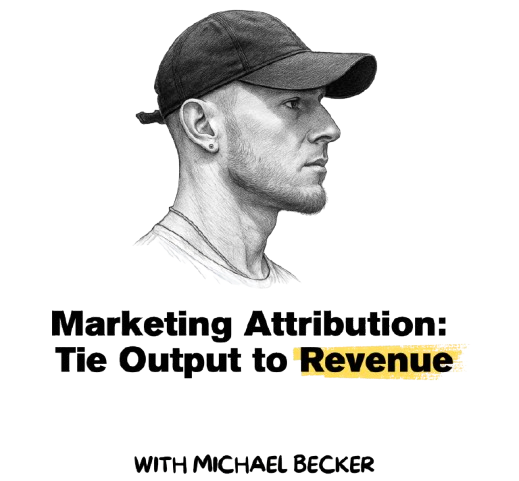Your cart is currently empty!

Marketing Attribution: How to Tie Commercial Activities to Revenue (10 KPIs)
I want to share a simple framework to tie marketing to business value.

The most important metrics for marketing teams are not “leads” or “meetings” or “closed-won” accounts. Yes, ultimately, those are the outcomes we want to drive, and will measure, but first we have to set the stage to enable them at all. Too many marketing people are trying to jump the gun.
If you want your inbound machine to compliment your outbound work the way it’s supposed to—the way it can—then content is how you’re going to get there.
In this new content economy, that means setting the stage for what I call “attention retention.”
To put it simply, it’s about getting found (capturing attention), building your list (converting attention), boosting engagement (expanding attention), then driving to purchase (cashing in on attention).
The way in which we enable that is by getting lots of people to find us, to keep coming back for more, to consume at increasing thresholds, then to self-select to learn more.
I’ve distilled the only top-funnel KPIs (and sub metrics) you need to worry about within a simple four-step measurement model. Here is what it looks like:

As you improve steps one, two, and three, outcomes around step four can balloon wider than what you can achieve by relying on prospecting alone. As a note, metrics also become weighted more heavily as you creep closer toward point-of-sale—depth of consumption among 50 subscribers is a greater indicator of success than getting 5,000 views. The timetable is going to be elongated as you move closer toward a sale, too.
Let’s break down each of these KPIs into sub metrics to tie it all together.
Capture
At the top of the framework, the Capture stage encompasses common vanity and visibility metrics most of us are familiar with. These metrics shouldn’t be weighted heavily, but they do have their place in understanding whether what you’re doing is getting in front of enough eyeballs.
Here, you should be looking at story and page views on social media along with website traffic, individual page views and open rates of your emails.

The best use for these metrics is simply to get a sense of whether you’re aligned with what the algorithms want to see and whether you have growing or declining visibility.
Much of this is determined by algorithms and search engines that index and crawl your content. Your ability to control the numbers here is limited but you can make inferences and pivots based on trends that you notice over time. Other than that, take these metrics with a grain of salt.
What to Measure
- Story views
- Page views
- Open rate
- Impressions
- Visitors
Convert
The next stage is to Convert the attention you control. Here, the goal is to turn anonymous viewers and unknown profiles into opted-in contacts. In short, it’s about building your list.
Growing your email list is one of, if not the, most essential projects to focus on pre-purchase. When someone subscribes, when they self-select to give you their email address, they consent to being notified every time you push out new content. And not just now, but forever—so long as the promise of perpetual value is kept. You now “own” that contact.

In time, you can start to do more advanced calculations to understand how much more valuable a subscriber is than a non subscriber. Specifically, you can measure how much more likely an opted-in subscriber is to:
- Like, share, and comment on content
- Repeatedly visit your content properties
- Also be a member of your private group
- Become a paying customer
- Become a higher-spending customer (ATV, CLTV)
- Do repeat business
Not all opted-in contacts are of equal value. Some types of subscribers, and some platforms, are generally more valuable than others. I recommend focusing on driving email opt-ins and private group requests—an entire chapter in my book is centered around the private group strategy. So, driving membership requests to a closed community is a massive opportunity.
Social followers are better than no followers (all things being equal, who would you be more likely to follow: a creator with 300 or 300,000 followers?), but they tend to be less tapped in than those receiving your newsletter updates where the opt-in threshold is higher.
What to Measure
- Followers across channels
- Subscribers across channels
- Form fills
- Group requests
Consume
Even more valuable than subscriber growth is how those subscribers—or even non-subscribers—interact with what you’re putting out. Are people finding enough value in your content to invest their precious time? Now we’re looking at content intake and consumption.
What we’re hoping to get a sense for is the degree of immersion with which people engage, indicating how valuable the market finds your content. To do that, we can use a three-dimensional matrix that takes into account repetition (are they coming back?), duration (are they viewing for a long time?), and depth (are they interacting?).

Virtually no marketers are thinking about duration of consumption or viewership repetition, yet these are two of the most valuable metrics creators should be concerned with long-term. Not only are they indicators of value, but they mean that people are returning and remaining, which is exactly what we want our audiences to do as they binge on our multimedia libraries. Through well-produced, even serialized media, you can hook people and get them salivating in anticipation of the next episode. Podcasts, weekly drops, and consistently-published videos are all emergent options. This is how top creators are controlling mindshare in their niche—with marketing that doesn’t feel like marketing.
Done well, this kind of content hypnotizes viewers by drawing them deeper into your world.
Depending on the platform, markers to measure here might include logins, view time, replays or backtracks, and archives or saves. With this stage in full motion, the chance of capitalizing becomes more likely—and a lot more natural.
What to Measure
- Sessions/logins
- Emails received
- Most engaged followers
- Dwell time
- Average view duration
- Reshares/saves
- Comment volume
- Scroll depth/hotspots (heat mapping)
Capitalize
The ultimate mandate is to tie marketing to revenue. As your media house gets built, and as time goes by, you should see a corresponding increase in nearly all metrics that matter for your organization, whether that’s group members, calls scheduled, or revenue.

For sole proprietors, it’s easy to draw causality between content and cash—what (but not whatever) you do drives 100% of revenue. Big organizations often have people dedicated to marketing operations whose job it is to create tracking systems and analyze effectiveness.
A lot of organizations use convoluted attribution models to tie marketing to revenue, and there tends to be internal politics at play between marketing and sales as to who “owns” a lead since it’s all tied to pay bonuses. This pervasive issue removes focus from the only thing that matters, the customer, and pits two parties who ought to be on the same side against each other in a negative-sum internal civil war. For those reasons, it often gets more difficult to trace sales to content the bigger an operation becomes. A simple fix here regardless of company size is to just ask your buyers, “Hey, by the way, where did you first find us? Do you remember?” That seemed to work great whether I was chatting with customers for my first e-learning product or in the big firms I’ve been with in the past. It bypasses all the back-and-forth, lets you hear straight from the customer's mouth, and gives you a good opportunity to connect with them to get valuable qualitative feedback.
Conclusion
Marketers are in the business of behavior change. Every KPI you’re measuring should tie to tactics geared to pull—not push—your audience deeper inward and ultimately to a sales event.
We should note that this is not an exhaustive list, nor is every metric outlined right for every type of business. You should find the metrics that move the needle for you, then optimize for them.
Armed with ammo surrounding these KPIs and the metrics associated with each, you can begin to merge the art of content with the science of marketing by calculating what works… all with content at the core.

Leave a Reply